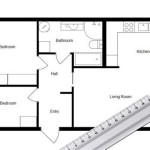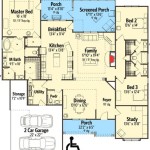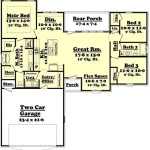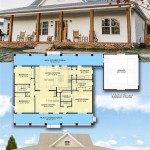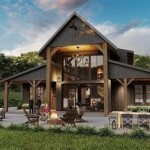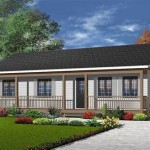Home Plans On Sloped Lots: Navigating Design Challenges and Maximizing Potential
Sloped lots present unique challenges and opportunities in home construction. While they may seem daunting compared to flat, easily buildable land, sloped lots can offer breathtaking views, distinctive architectural designs, and enhanced privacy. Success in building on a slope hinges on careful planning, a thorough understanding of site conditions, and the selection of a home plan that harmonizes with the natural terrain. This article explores the key considerations and design options for home plans on sloped lots, focusing on strategies to leverage the inherent advantages while mitigating potential drawbacks.
Understanding Site Assessment and Geotechnical Considerations
Before even considering specific home plans, a comprehensive site assessment is paramount. This assessment should include a topographic survey, which maps the contours of the land, identifying the steepness of the slope, existing drainage patterns, and potential areas for building. A geotechnical investigation, involving soil testing and analysis, is equally crucial. This investigation determines the stability of the soil, its load-bearing capacity, and its susceptibility to erosion or landslides. The geotechnical report will inform the foundation design and any necessary site stabilization measures, such as retaining walls or soil compaction.
Understanding the local climate is also a critical aspect of the site assessment. Rainfall patterns, snow accumulation, and wind exposure can significantly impact the design and construction process. For example, in areas with heavy rainfall, proper drainage systems are essential to prevent water damage and erosion. Similarly, exposure to strong winds may necessitate structural reinforcements to ensure the home's stability. The orientation of the slope relative to the sun's path also influences the energy efficiency of the home. South-facing slopes generally receive more sunlight, which can be advantageous for solar heating but may also require shading strategies to prevent overheating during the summer months.
Furthermore, accessibility should be considered. The ease of access for construction equipment, materials, and future residents is a major factor influencing cost and design choices. Steep slopes may require extensive grading or the construction of access roads, which can add significantly to the overall project expense. Environmental regulations and permitting requirements should also be thoroughly investigated. Local authorities may have specific restrictions on grading, vegetation removal, and stormwater management on sloped lots.
Exploring Foundation Options for Sloped Terrain
The foundation is the most critical element of a home on a sloped lot, as it must provide a stable and level base for the structure while accommodating the uneven terrain. Several foundation options are commonly employed, each with its own advantages and disadvantages depending on the specific site conditions and the desired aesthetic.
Walkout Basements: This is perhaps the most popular and cost-effective foundation choice for moderately sloped lots. A walkout basement is essentially a basement that is partially or fully exposed on one side, allowing direct access to the outdoors. This design leverages the natural slope to create usable living space at the basement level. Walkout basements can significantly expand the home's square footage without adding to the overall footprint, and they often provide ample natural light and ventilation. They are well-suited for creating recreational areas, home offices, or guest suites. The cost of a walkout basement is generally lower than other foundation options, as it requires less excavation and concrete work.
Daylight Basements: Similar to walkout basements, daylight basements are partially exposed, but typically to a lesser extent. They usually have smaller windows above grade, allowing natural light to penetrate the basement level. Daylight basements are a good option for slopes that are not steep enough for a full walkout basement but still offer some level change. They provide a cost-effective way to add living space and can be used for various purposes, such as storage, workshops, or recreational areas.
Stem Wall Foundations: Stem wall foundations consist of concrete walls that extend above the ground to create a level platform for the home. This type of foundation is often used on moderately sloped lots where the slope is relatively consistent. Stem walls can be constructed using poured concrete or concrete blocks. The height of the stem walls will vary depending on the steepness of the slope, and they may require reinforcement to withstand lateral soil pressure. Stem wall foundations are relatively straightforward to construct and can provide a stable base for the home, but they may not be the most visually appealing option, as they can appear somewhat bulky.
Pier and Beam Foundations: Pier and beam foundations are typically used on steeper slopes or in areas with expansive soils. This type of foundation involves setting concrete piers deep into the ground to support a network of beams that create a level platform for the home. Pier and beam foundations elevate the home above the ground, allowing for air circulation and preventing moisture buildup. They also minimize the amount of excavation required, which can be advantageous on steep slopes. However, pier and beam foundations can be more expensive than other options, as they require specialized engineering and construction techniques.
Split-Level Designs: Split-level designs are specifically tailored for sloped lots, creating different living areas at varying elevations. This design effectively integrates the home with the slope, minimizing excavation and maximizing the use of space. Split-level homes typically have three or more levels, with short flights of stairs connecting each level. This design can create a dynamic and visually interesting interior layout, and it can also offer privacy between different living areas. However, split-level homes may not be suitable for individuals with mobility issues, as they require frequent use of stairs.
Integrating Home Design with the Natural Landscape
The most successful home plans on sloped lots are those that seamlessly integrate with the natural landscape. This involves carefully considering the views, the existing vegetation, and the surrounding topography when designing the home. The goal is to create a home that feels like it belongs on the site, rather than being imposed upon it.
Maximizing Views: One of the primary advantages of building on a sloped lot is the potential for stunning views. The home should be oriented to take full advantage of these views, with large windows and outdoor living spaces strategically positioned to capture the best vistas. Decks, patios, and balconies can extend the living space outdoors and provide unobstructed views of the surrounding landscape. The placement of windows should also consider the angle of the sun to minimize glare and heat gain. Overhangs, awnings, and strategically placed trees can provide shading during the hottest parts of the day.
Preserving Existing Vegetation: Whenever possible, existing trees and vegetation should be preserved during the construction process. Trees can provide shade, privacy, and aesthetic appeal. They can also help to stabilize the soil and prevent erosion. A landscape architect can help to develop a plan that integrates the home with the existing vegetation and incorporates native plants that are well-suited to the local climate and soil conditions. Invasive species should be removed to protect the health of the native ecosystem.
Using Natural Materials: Using natural materials in the construction of the home can help it to blend in with the surrounding landscape. Stone, wood, and other natural materials can create a warm and inviting aesthetic that complements the natural beauty of the site. These materials can also be more durable and require less maintenance than synthetic materials. The exterior cladding of the home should be chosen to complement the colors and textures of the surrounding landscape. For example, a home built on a wooded lot might feature siding that is stained in a natural wood tone, while a home built on a rocky hillside might incorporate stone accents.
Minimizing Site Disturbance: Every effort should be made to minimize site disturbance during the construction process. This includes limiting the amount of grading and excavation required, protecting existing trees and vegetation, and implementing erosion control measures. Best management practices for stormwater runoff should be implemented to prevent pollution of nearby waterways. The construction site should be kept clean and organized to minimize the impact on the surrounding environment.
Considering Passive Solar Design: Passive solar design principles can be incorporated into the home's design to maximize energy efficiency. This involves orienting the home to take advantage of the sun's path and using thermal mass to store heat during the day and release it at night. South-facing windows can capture solar heat during the winter months, while overhangs and shading devices can prevent overheating during the summer months. Proper insulation and air sealing are also essential for maximizing energy efficiency.
In conclusion, building on a sloped lot requires careful planning, a thorough understanding of site conditions, and a design that harmonizes with the natural terrain. By addressing the challenges proactively and embracing the opportunities presented by the slope, it is possible to create a beautiful and functional home that takes full advantage of its unique setting.

Plan 51696 Traditional Hillside Home With 1736 Sq Ft 3 Be

Looking For The Perfect Affordable Cottage With A Large Covered Balcony Plan 1143

Modern House Plan Sloping Lot Contemporary Style 5590 Vista

Sloped Lot House Plans Down Slope The Designers

Duplex For A Down Sloping Lot 8188lb Architectural Designs House Plans

Home Plan Ch507

Modern House Plans For Sloped Lots Fresh 29 Best Steep Slope Images On Sloping Lot Plan Design

Sloped Lot House Plans With Walkout Basements At Dream Home Source Unique Modern Architecture

A Guide To Sloping Lot House Plans

House Plans Home Designs

